
 |
mSATA SSD slot for small capacity mSATA SSD to enable Intel Smart Response. Intel Smart Response can enhance system speed and this port is sharing with SATA2 5. 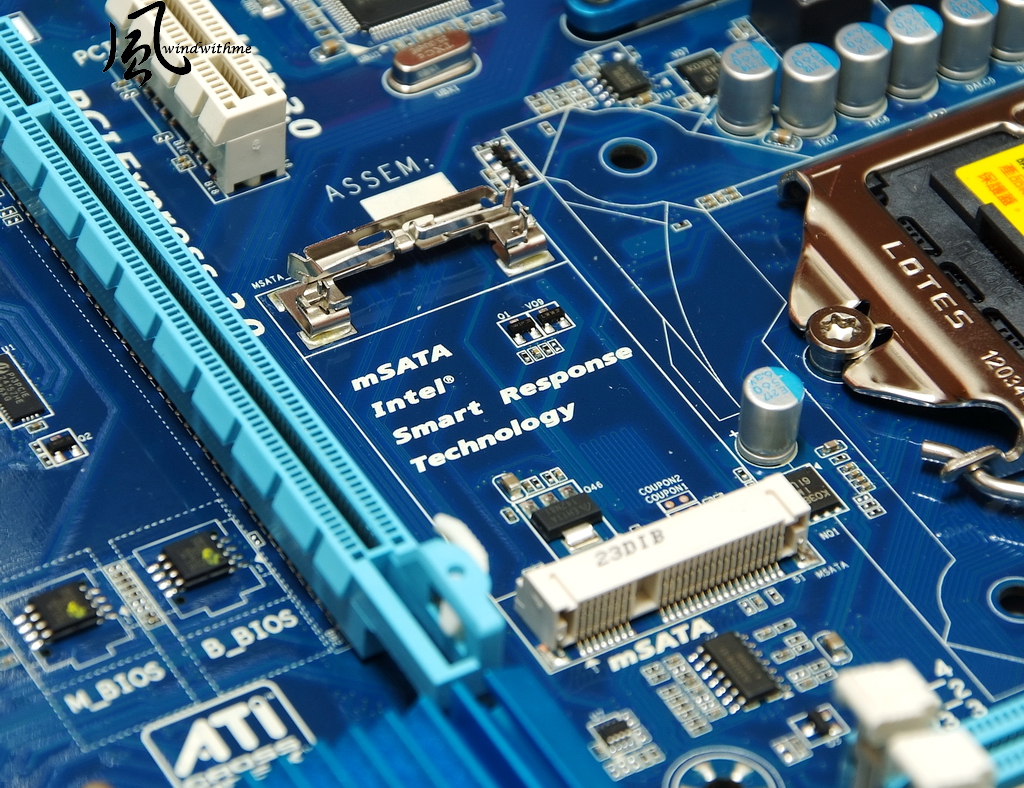 Blue heat-sink provides bigger cooling zone by special cut. Besides gorgeous color, the light source will change the deep or light color. 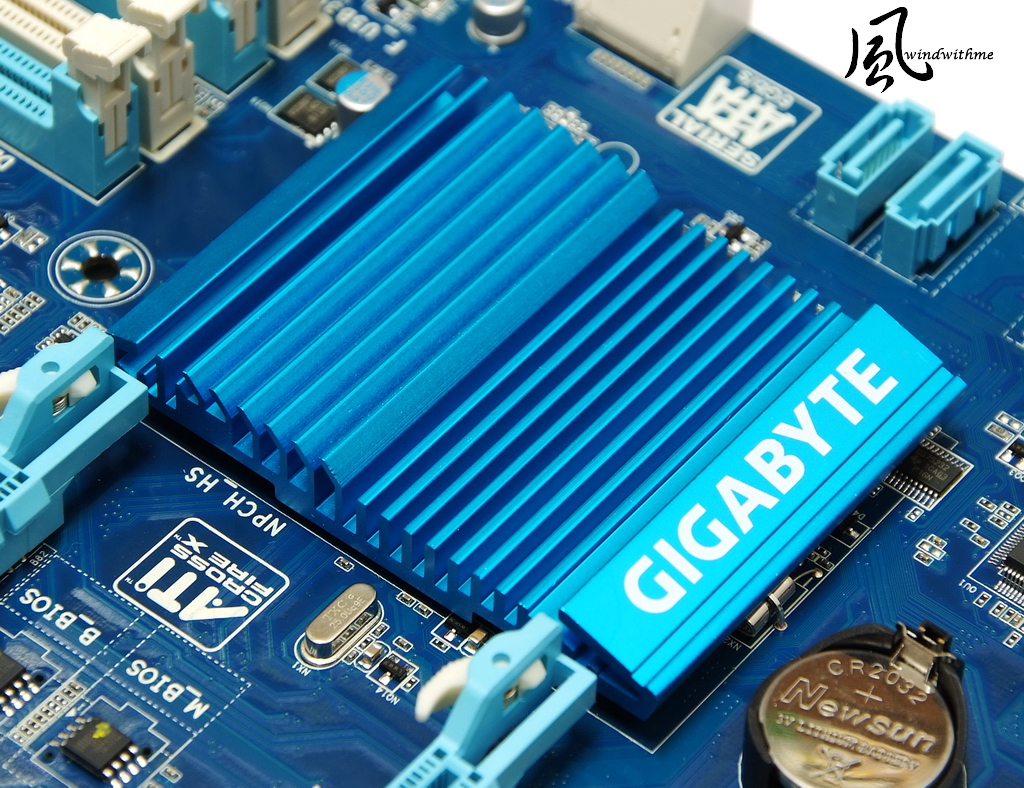 GIGABYTE changes Realtek chipset which is more compatible and faster update this time. LAN chip is Atheros GbE. In NoteBook or AP field, Atheros connection capability has very good reputation. Audio chip uses VIA VT2021. If you are studying audio card, you should be impressive at VIA Envy24. VIA merged audio chip company years ago. Envy24 172X is the most famous product in audio card. They have as cheap as 20USD, also some high end brands audio card which are 200~300USD. I hope VIA VT2021 can adopt Envy24 tradition. I will share the audio experience later. 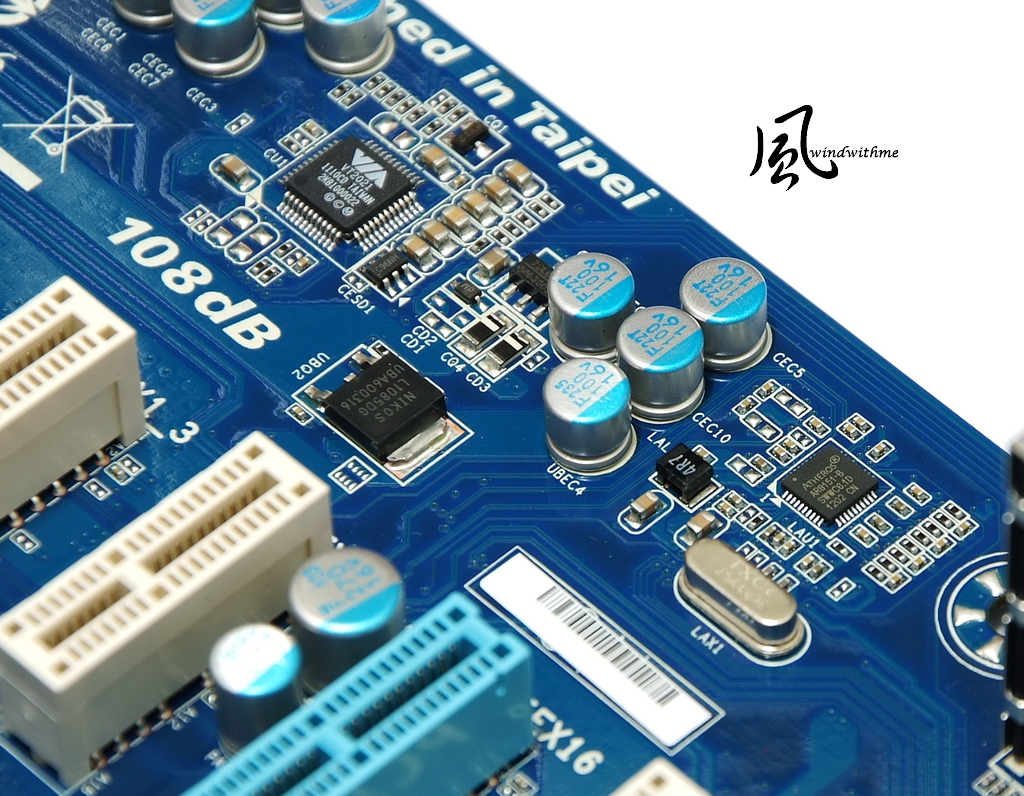 UEFI M.I.T. main page You can easily see the hardware status in the bottom.  CPU Clock Ratio set to 48, which is 4800MHz. Enable X.M.P., the DDR3 set to 2133 as its spec. System Memory Multiplier adjust to 26 by DDR3 quality, which is DDR3 2600.  Advanced CPU Page You can adjust individual CPU Core ratio. You also can choose how many cores to enable. I am used to disable C1E/C3C6 and EIST, power saving features, when I am OC.  DDR3 Main Page. X.M.P. items and clock can be set in previous page. 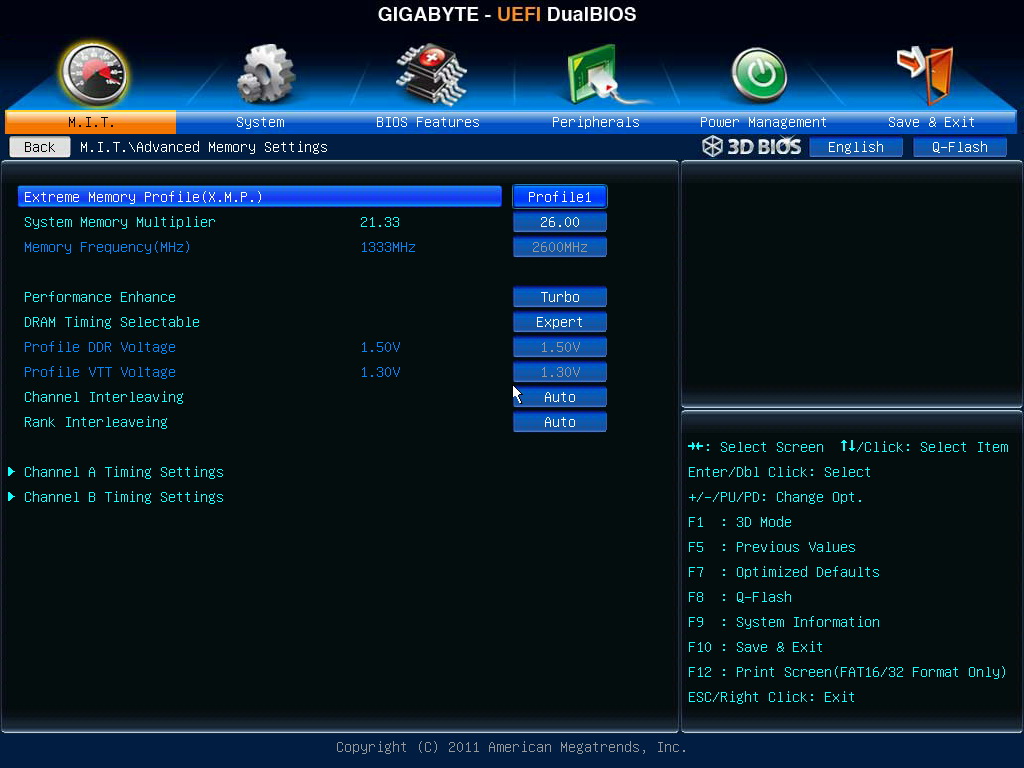 DDR3 2600 latency is CL12 13-13-32 2T  OC Voltage Items CPU Vcore 0.800~1.900V CPU Vtt 0.800~1.680V My 3570K OC to 4.8GHz requiring 1.340V at CPU Vcore.  DRAM Voltage 1.200~2.400V DDR3 2600 stable voltage is 1.660V 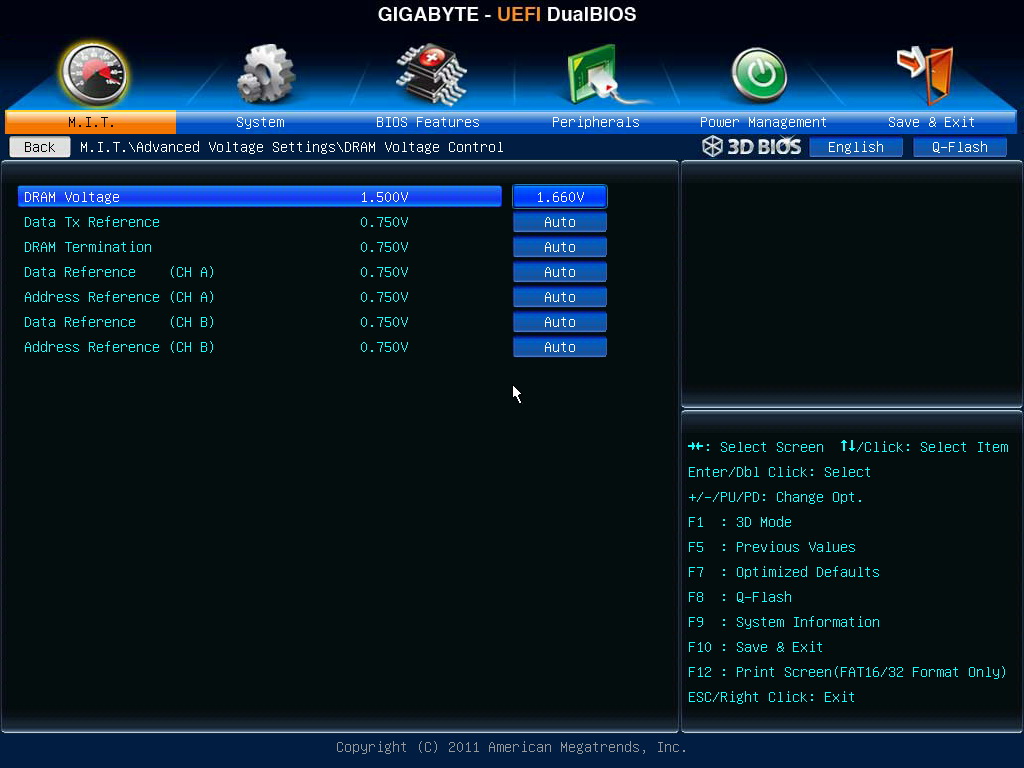 |
Internal Graphics enable Lucid MVP technology.  PC Health Status  Ivy Bridge OC setting is much easy than the past. However, you need Z77 and K series CPU in advance. If you donít meet the criteria, the CPU frequency OC range will be very small. Also, OC CPU clock will pull high PCI-E as well, you also need to consider the product life for long time usage. Z77 with 3570K CPU, you just need to rise CPU clock, then fine tune by CPU quality and cooling devices. Test Configuration CPU: Intel Core i5-3570K MB: GIGABYTE Z77-D3H DRAM: CORSAIR DOMINATOR-GT CMT16GX3M4X2133C9 VGA: Intel HD Graphics 4000 / Galaxy GTS450 1G DDR5 HD: SanDisk Extreme 240GB POWER: CORSAIR AX650W Cooler: CORSAIR Hydro Series H100 OS: Windows7 Ultimate 64bit 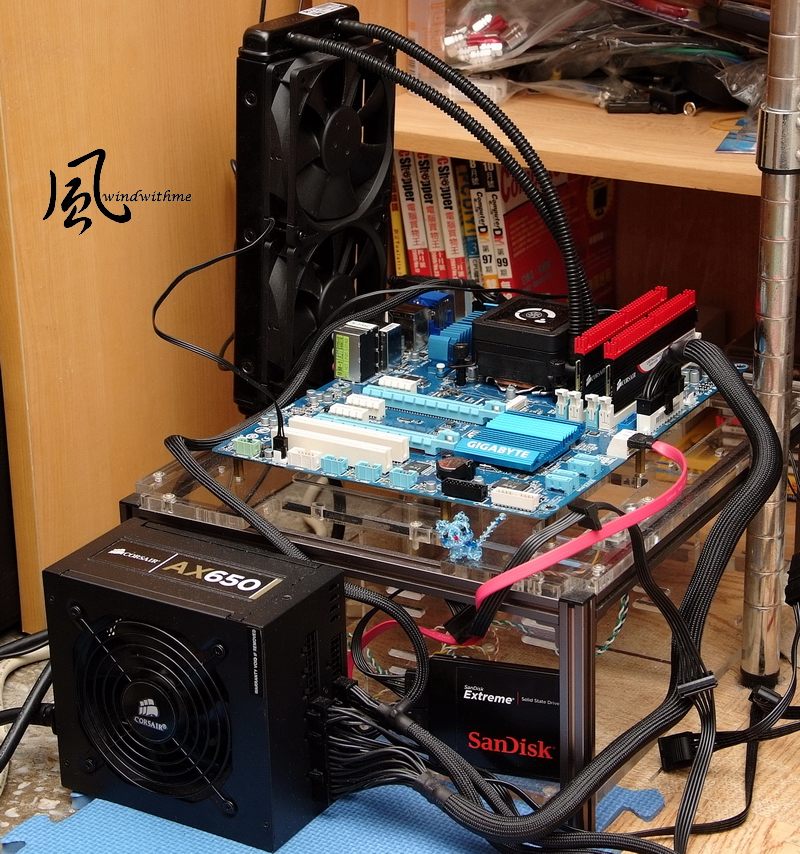 First of all, letís compare Intel latest HD Graphics 4000 and nVIDIA GTS450 in default mode. HD Graphics 4000 3DMark Vantage => P4689  nVIDIA GTS450 3DMark Vantage => P11447  StreetFighter IV Benchmark 1920 X 1080 HD Graphics 4000 => 53.11 FPS  nVIDIA GTS450 => 138.50 FPS  FINAL FANTASY XIV 1920 X 1080 HD Graphics 4000 => 864  nVIDIA GTS450 => 2140  LOST PLANET 2 DX11 1920 X 1080 TEST A HD Graphics 4000 => 11.1 fps  |
nVIDIA GTS450 => 25.8 fps 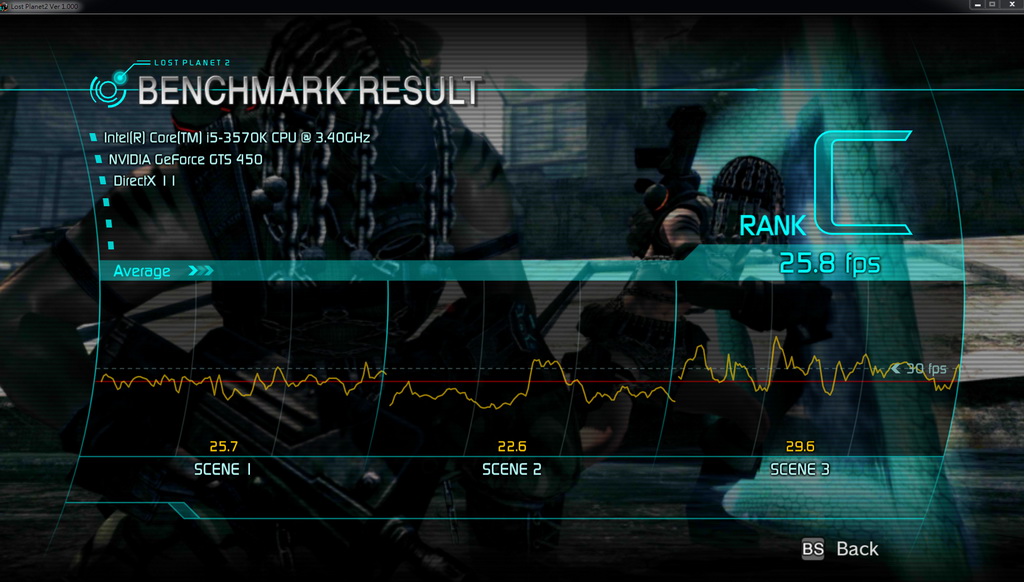 HD Graphics 4000 performance has 30%~50% improvement comparing to HD Graphics 3000. The IGP 3D performance is similar to AMD A8-3850 Radeon HD6550D. The performance is still a big gap with nVIDIA GTS450. However, itís over GT430 / GT520 and close to GT440. Most Z77 MBs support Lucid MVP technology. It will enhance HD Graphics 4000 performance for further 3D applications. File converting performance test. The GPU still use Intel HD Graphics 4000 / nVIDIA GTS450 Output interface is DVI on GTS450 and switch GPU by software. MediaEspresso is the video converter for comparing IGP and external VGA. DVD File VTS_01_1.VOB, 1023MB and convert to MP4 file. Intel HD Graphics 4000 Upper-Left is Virtu MVP features. Enable Intel Quick Sync Video(Better quality)  4 mins 12 secs 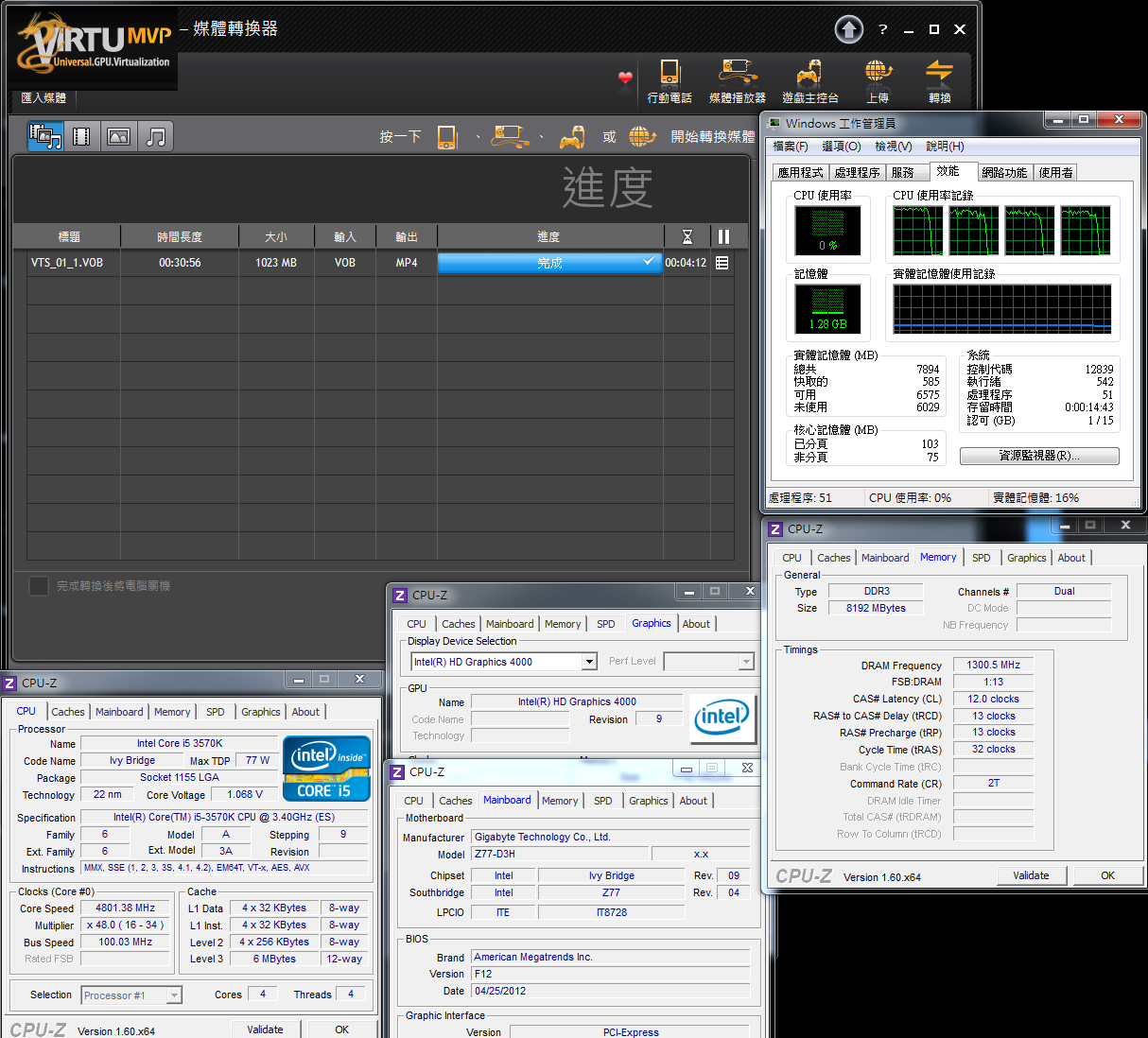 Galaxy GTS450 Lower-Left enable nVIDIA CUDA Technology  4 mins 52 secs  I used same video file to test. Intel Quick Sync Video is 40 seconds faster than nVIDIA CUDA. Using Intel HD 4000 can save 16% time. For users who have high demand of video converting, you can save lot of time. Also, Intel claimed Ivy Bridge for Intel Quick Sync Video is much faster than Sandy Bridge as well. If I have time, I will use SNB to compare the real performance difference of Intel Quick Sync. Z77-3DH CPU and system performance in OC condition. CPU 100.3 X 46 => 4801.29MHz(Disable Turbo Boost and C1E) DDR3 2600.8 CL12 13-13-32 2T(Enable XMP Mode) Intel HD Graphics 4000 1150MHz Hyper PI 32M X4 => 7m 27.658s CPUMARK 99 => 757 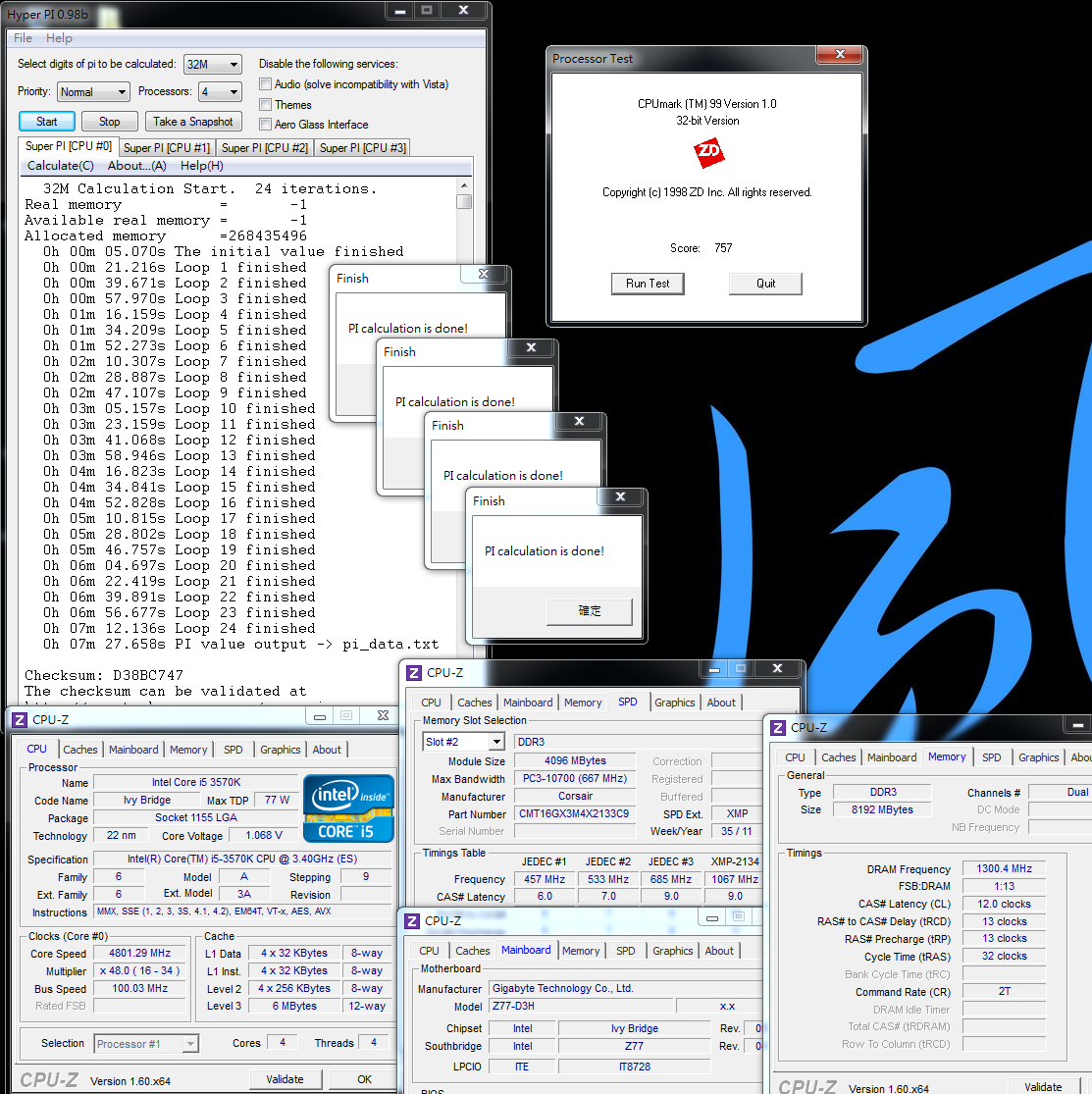 Nuclearus Multi Core => 29517 Fritz Chess Benchmark => 30.06/14430  CrystalMark 2004R3 => 367177  CINEBENCH R11.5 CPU => 7.98 pts CPU(Single Core) => 2.04 pts  FRYRENDER Running Time => 5m 38s x264 FHD Benchmark => 23.8  |
PCMark Vantage => 23602 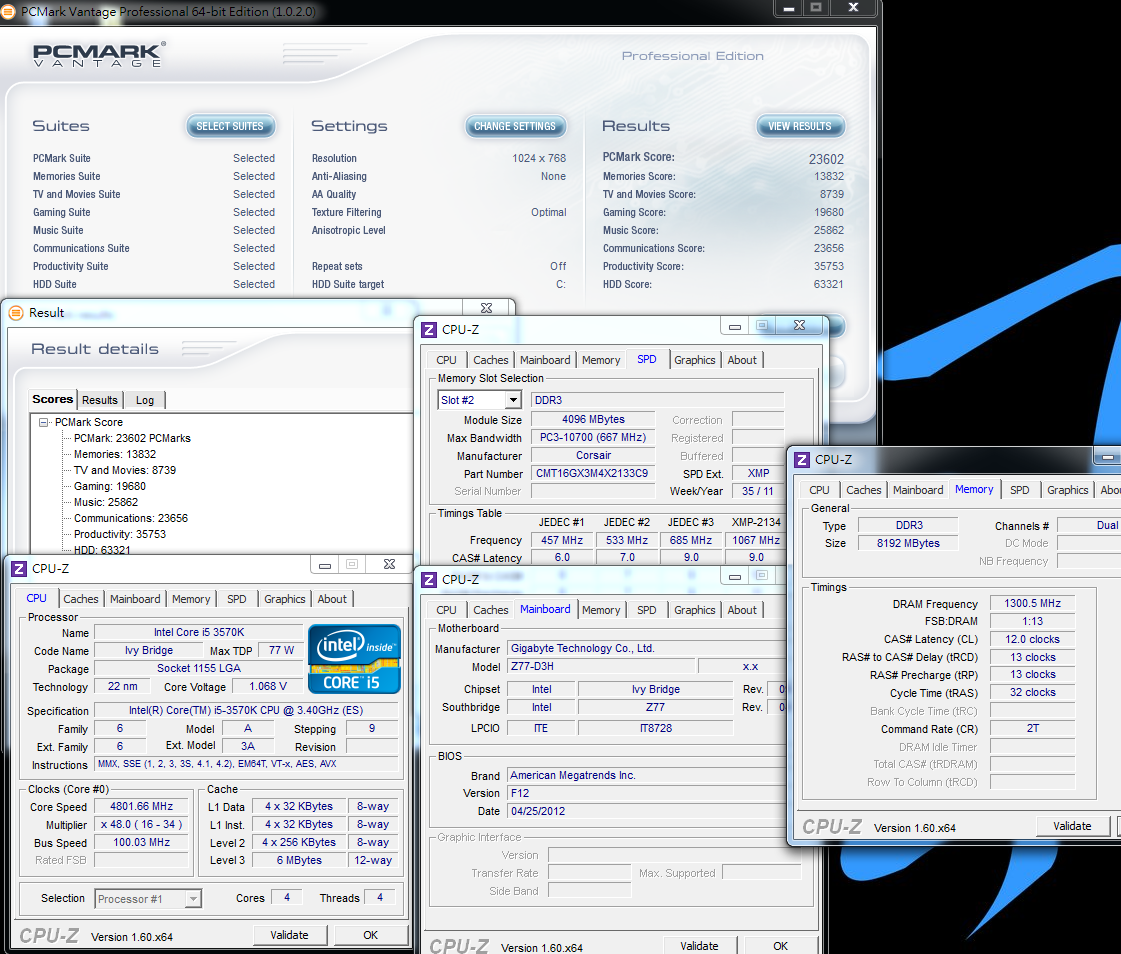 i5-3570K OC ability is similar to i7-3770K, but 3770K performance is 25% higher than 3570K as same frequency. The CPU performance difference is caused by L3 cache and HT technology. However, the price gap is another key issue. Ivy Bridge 3570K juxtapose with Sandy Bridge 2500K, the performance is 6% higher. Itís lower than 3770K got 6~14% higher than 2770K. 3570K is capable for most software. Itís most preferred CPU in mid-end market. DRAM Bandwidth Test DDR3 2600.8 CL12 13-13-32 2T ADIA64 Memory Read - 23710 MB/s Sandra Memory Bandwidth - 28905 MB/s MaXXMEM Memory-Copy - 28308 MB/s  Ivy Bridge DDR3 bandwidth is close to Sandy Bridge. The key difference is Ivy Bridge can upgrade DDR3 clock to 2~3 higher levels. If DDR3 quality is good enough, you can run at 2600~2666 which is good enough for users demand for high clock. Z77-D3H can reach DDR3 2600 easily. It will be better if the bandwidth is higher. Temperature(Room is 32˚C) Enter to OS Desktop - 38~45  CPU Full Speed by Linx - 79~90  Even though you have some ideas of Ivy Bridge temperature from my previous 3770K reviews. This time, the room temperature is quite high. i5-3570K OC 4.8GHz numbers are higher of course. I used to expect 3570K, without HT, can be lower. So far, it seems the same with 3770K. If you want to OC 3570K / 3770K to 4.8GHz, cooling devices is the key factor. Power Consumption Enter to OS Desktop - 67W  CPU Full Speed by Linx - 163W 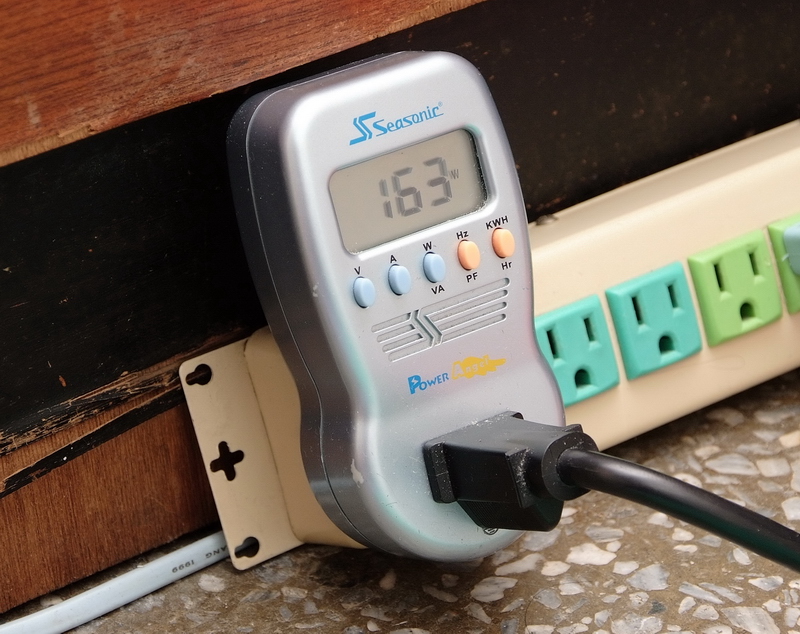 If only use IGP HD Graphics 4000, the power consumption is similar to 3770K in OS desktop. As 4.8GHz, 3570K is 12W lower than 3770K which is not big difference. These two CPU still owns Ivy Bridge 22nm advantage which is must power saving than former 32nm. GIGABYTE Z77-D3H Pros 1. Z77 series white color box and booting screen is improved. 2. Using UEFI BIOS technology and provide two interfaces for choice. 3. Itís standard ATX PCB and built-in my personal preferred Atheros LAN and VIA audio. 4. OC ability is excellent. CPU can run at 4.8GHz stable and DDR3 can reach 2600MHz as well. 5. Back IO panel provides 4 USB 3.0 ports and exclusive mSATA SSD slot. Cons 1. DDR3 2600 bandwidth need to be improved 2. CPU-Z cannot detect the real voltage  Performance ★★★★★★★★★☆ 88/100 Components ★★★★★★★★☆☆ 77/100 Specification ★★★★★★★★☆☆ 83/100 Appearance ★★★★★★★★☆☆ 77/100 C/P Value ★★★★★★★★★☆ 92/100 This review is focus on Ivy Bridge mid-end OC platform, Z77 with Core i5-3570K. 3570K is following model of 2500. The temperature and power consumption are similar to 3770K. OC range is also close to 3770K. If your cooling and CPU quality are good enough, 4.8GHz is easy to keep stable run. However, in terms of price, 3570K is much lower than 3770K. If you are not heavy overclockers, 3570K is good option for you.  GIGABYTE Z77-D3H uses VIA VT2021 audio chip. I use Realtek ALC892 to compare with it by headset. VT2021 medium frequency is better, especially in vocal. For high frequency and stress are similar. If you are always listening music, you can consider to use VIA VT2021 to have better quality in medium frequency. Z77-D3H price is a little bit higher than entry Z77 MB, but the spec make it have better C/P value. The OC ability is close to high end Z77. LAN and audio chips are also better in my personal experience. This time, even though Intel Z77 is most high end Ivy Bridge chipset, but the price is lower than the past as launching stage. Maybe itís the result of market and competition. Users can lower their budget to get latest platform. :) This review is also post in my blog WIND3C. Any comments are welcome. |
| All times are GMT +1. The time now is 09:42. |
Powered by vBulletin® - Copyright ©2000 - 2024, Jelsoft Enterprises Ltd.
Content Relevant URLs by vBSEO